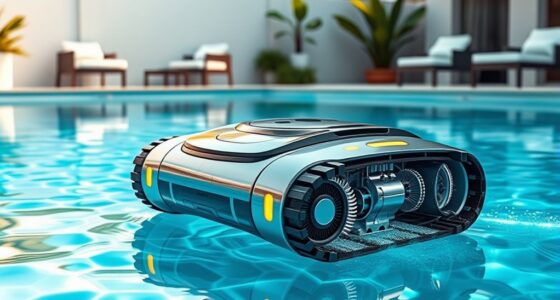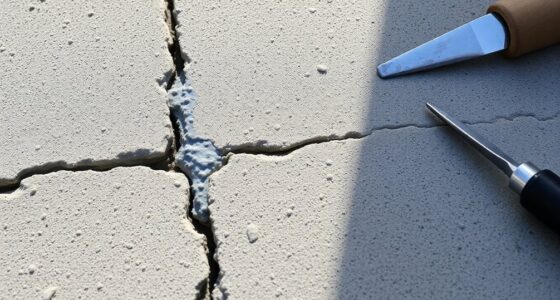To troubleshoot fire extinguishers, start by checking that the pressure gauge needle is in the green zone and inspect for any signs of damage, corrosion, or leaks. Confirm the nozzle and hose are clear and securely attached. Verify the safety pin and tamper seal are intact, and look for expired service or inspection dates. Proper storage in accessible, safe locations is essential. For more tips on maintaining different types of extinguishers, keep exploring these guidelines.
Key Takeaways
- Identify the specific fire extinguisher type (ABC, CO2, foam, etc.) to follow appropriate troubleshooting procedures.
- Verify pressure gauge readings are within the recommended green zone for each extinguisher type.
- Check for physical damage, corrosion, or blockages specific to the extinguisher’s design and contents.
- Confirm proper storage conditions tailored to the extinguisher type to prevent deterioration or accidental discharge.
- Ensure the extinguisher is within its service and expiration date, and schedule professional inspections as needed.
Common Mistakes and Maintenance Tips for Fire Extinguishers

Fire extinguishers are vital safety tools, but they only work effectively if they’re properly maintained and ready to use. Regular fire extinguisher maintenance is essential to ensure that when you need it most, it performs reliably. One of the most common issues people face with extinguishers involves common extinguisher errors, which often stem from neglect or improper handling. Recognizing and correcting these mistakes can make the difference between a quick, effective response and a failed effort during an emergency.
First, always check the pressure gauge to confirm it’s in the operable range. An extinguisher with a needle outside the green zone might look fine, but it may not discharge properly. Many overlook this simple step or forget to re-pressurize after use or maintenance. Also, inspect the safety pin and tamper seal to ensure they’re intact. If the seal is broken or missing, the extinguisher might have been used or tampered with, rendering it unreliable. Many people make the mistake of ignoring these visual cues, which can lead to using an ineffective extinguisher in critical moments.
Always check the pressure gauge and tamper seal to ensure extinguisher readiness.
Next, examine the physical condition of the extinguisher. Look for corrosion, rust, or dents that could compromise its integrity. Corrosion, especially around the nozzle or cylinder, can cause leaks or blockages, reducing the extinguisher’s effectiveness. Dents or damage to the cylinder might indicate it’s no longer safe or capable of withstanding pressure, so it should be replaced or professionally inspected. Many forget to perform these detailed inspections, risking failure during an emergency.
Another common extinguisher error involves improper storage or placement. Keep extinguishers in accessible, visible locations, away from heat sources or electrical equipment that could damage them. If stored improperly, you might not be able to reach it quickly, or it could be rendered unusable due to exposure to elements. Also, ensure that the nozzle or hose is clear and unobstructed. Blockages or debris can prevent the discharge of extinguishing agent when needed.
Finally, remember that extinguishers have expiration or service dates stamped on them. Using an expired extinguisher is ineffective and a frequent mistake. Regular maintenance includes professional inspections and recharging as needed. Proper maintenance and avoiding common extinguisher errors ensure your safety equipment functions when it matters most. By scheduling routine fire extinguisher maintenance and avoiding common extinguisher errors, you guarantee your safety equipment functions when it matters most. Proper care, prompt repairs, and mindful storage keep your fire extinguishers ready to protect you and your property.
Frequently Asked Questions
How Often Should Fire Extinguishers Be Inspected?
You should inspect your fire extinguishers monthly to guarantee they’re in good working condition. Follow your maintenance schedules closely, and have professional inspections annually. Regular inspections help identify any issues like pressure loss or damage. Don’t forget to check the accessibility and physical condition of the extinguisher. Keeping to these inspection frequencies and maintenance routines ensures your fire extinguishers are ready when you need them most.
What Is the Lifespan of a Fire Extinguisher?
Your fire extinguisher’s lifespan typically ranges from 5 to 15 years, but don’t wait until it’s too late. Regular inspections reveal when it’s time for replacement, ensuring safety. Keep a close eye on the replacement schedule, and remember, even if it looks fine, internal components can degrade. Act now—know your extinguisher’s age, and never compromise on safety. Your quick action could be the difference in an emergency.
Can Fire Extinguishers Be Used for Electrical Fires?
Yes, you can use a fire extinguisher for electrical fires if it’s compatible with electrical safety. Look for extinguishers labeled for Class C fires, which are designed specifically for electrical equipment. Using the right extinguisher guarantees effective safety measures and prevents electrical hazards from worsening. Always check extinguisher compatibility before use, and remember to keep electrical safety in mind to protect yourself and others during such emergencies.
How Do I Properly Dispose of an Expired Extinguisher?
You shouldn’t just toss an expired extinguisher in the trash; it can be hazardous. Instead, you need to follow proper disposal methods for expired extinguisher disposal. Take it to a local fire department or a certified recycling center that handles hazardous materials. They have the proper equipment to safely dispose of or recycle the extinguisher, preventing environmental harm and ensuring safety. Always check local regulations for specific instructions in your area.
Are There Different Maintenance Requirements for Each Extinguisher Type?
Yes, different extinguisher types require specific maintenance and inspection procedures. You need to regularly check pressure gauges, guarantee no damage or corrosion, and verify the nozzle’s cleanliness. For example, dry chemical extinguishers need thorough shaking to prevent clumping, while CO2 models require valve inspections. Follow manufacturer guidelines for extinguisher maintenance and inspection procedures to keep each type functioning effectively and safely in emergencies.
Conclusion
Now that you know the different fire extinguisher types and how to maintain them, you’re better prepared to handle emergencies. Regular checks and proper usage can make all the difference when seconds count. Remember, an ounce of prevention is worth a pound of cure—don’t wait until it’s too late. Keep your fire safety gear in top shape so you’re ready to act swiftly if the situation arises. Stay vigilant and stay safe!









